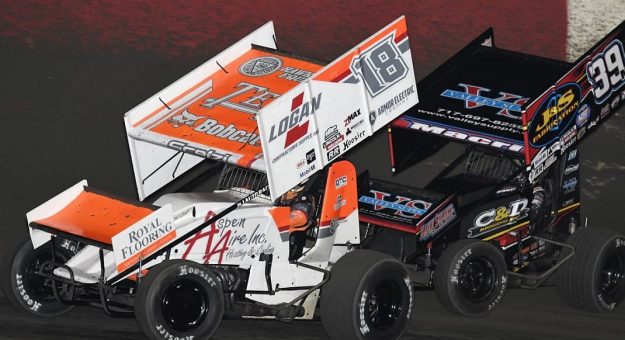DAYTONA BEACH, Fla. — The sprint car community was caught off guard on Jan. 29 when Gio Scelzi and KCP Racing rolled into the pit area at Georgia’s Screven Motor Speedway with a Toyota engine aboard the team’s familiar orange-and-white No. 18.
Toyota’s ambition to become a sprint car engine manufacturer had been well known for more than a year — they announced those plans in December of 2019 — but the rollout of those plans had been shrouded in secrecy.
Over the last two weeks, the early stages of Toyota’s competitive debut on the sprint car scene became clear. They came to compete, to learn and, eventually, to win.
“I said for years that (a Toyota sprint car engine) was on our bucket list,” said David Wilson, the president and general manager of Toyota Racing Development, on Thursday during a media conference call. “It was just about apportioning the resources to do it and finding the right partners to make sure that we did a good job with it. So very quietly last year, we pulled the trigger and decided that this was the right time. We had some resources that we could apply toward it and we had some partners willing to work with us.
“It hit the track for the first time in anger a couple of weeks ago, with Gio, and he’s taken it to its first few races,” Wilson added. “The first race out, he finished respectably, and then he won a dash in his second race out. So there’s potential there, but we definitely still have plenty of work to do on it.”
In Scelzi’s first three outings, split between Screven and Florida’s East Bay Raceway Park, his Toyota-powered sprint car finished seventh, sixth and fifth, respectively, showing progressive improvement.
The field became more competitive during the 50th DIRTcar Nationals at Volusia Speedway Park in Barberville, Fla., where Scelzi’s best run was 15th against a mixed field of All Star Circuit of Champions and World of Outlaws NOS Energy Drink Sprint Car Series regulars, but the learning curve continued.

Toyota’s week at Volusia wasn’t anything to write home about, Wilson admitted, but that’s to be expected when a manufacturer is building an engine program from the ground up.
“I’m moderate in our expectations. It’s a brand-new power plant,” Wilson noted. “It looks great and I’m confident knowing our guys and knowing the guys that we’re working with that it’s going to be a great piece. The biggest problem we have right now is just fending off all the people wanting to help (with it).”
Wilson views Toyota’s sprint car engine program as an integral piece of the brand’s support of grassroots dirt racing, joining its longstanding midget program that began more than a decade ago.
“It really fills out our position as a manufacturer in dirt racing, because the number of races every year that are contested between midgets and sprints are too many to count,” Wilson pointed out. “It’s something we’re really excited about.”
That’s a big statement, and one that Wilson stressed more than once during the media call.
Toyota’s entry into sprint car racing isn’t solely about expanding the company’s driver-development program, as some people might want to believe. It has a much broader, and simpler, purpose.
“This is about racing on dirt with a sprint car,” Wilson stated.
Wilson has seen manufacturer competition return to sprint car racing, first with Ford Performance and now with Toyota’s move to join the fray.
However, different from Ford’s strategy of aligning solely with Tony Stewart/Curb-Agajanian Racing for now, Wilson wants to see Toyota engines utilized by many sprint car teams when the time comes.
“In order for us to define success with this program, it needs to be commercially competitive,” Wilson explained. “It needs to be a product that’s available for whomever wants to run it. Our initial engagement in the midgets wasn’t about driver development. It was just about racing on dirt and it was about grassroots participation. It was about being there and getting to know the fans that go to the dirt track every Friday night. That was our attraction, and the driver development became a by-product that now, we’ve obviously doubled down on.
“It does certainly provide another part of the ladder for our driver development, but it’s not solely about driver development.”
As for Scelzi’s involvement, Wilson tipped that the young Californian will continue to help with the early development of the Toyota sprint car engine as the bugs are worked out and its performance improves.
“Gio has a great deal of experience. He can help us develop this, but certainly that won’t limit him in going other places (in the future), if the right opportunities present themselves for him,” said Wilson. “As to a team strategy, we haven’t formulated whether we’re going to pick one or two headliners to get our presence out there from a factory basis right now.
“We’re trying to make sure that this program is a viable endeavor right now, but I think we’ll have several opportunities if we decide to put a factory effort together. That just hasn’t been decided yet.”
